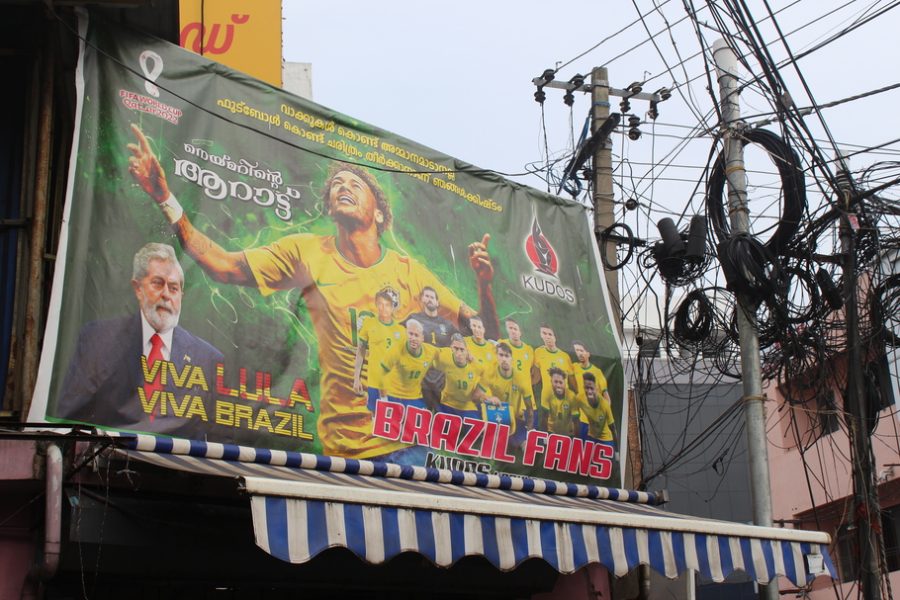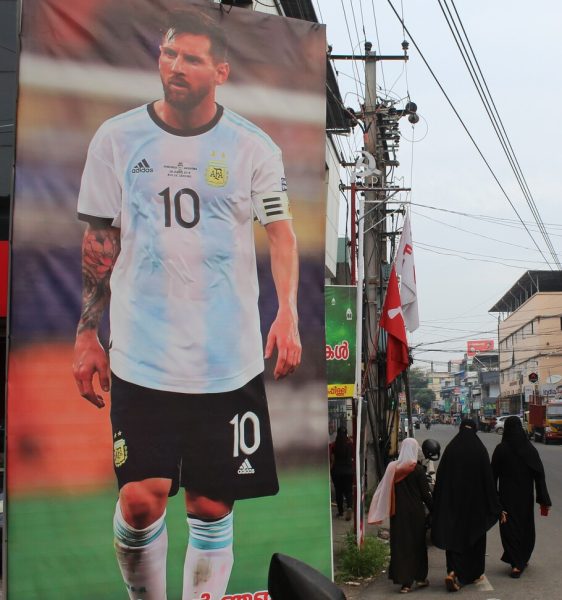
For football-crazy Kerala, FIFA World Cup is its biggest festival
Kerala’s love for Latin American football might have deeper psychological roots, since both regions share Left politics, workers’ movements, natural features, and the prevalence of the Church

“This is not just a ball. If you play well, this will take you around the world.”
This dialogue from the 2018 Malayalam movie Captain, uttered calmly by a football fanatic from Malappuram (the bedrock of football in Kerala), gave goosebumps to the audience. The deep-rooted love and passion for football rampant among Keralites is the secret thread that emotionally connected the audience with the theme. Now, the massive cut-outs of Lionel Messi, Neymar Jr, and Cristiano Ronaldo, erected in the small isles of a village river in Kozhikode district of the Malabar region, have taken the much-celebrated soccer mania of Kerala around the world.
A (local) controversy created a bit of confusion though. There were reports that the panchayat authorities had directed fans to remove the cut-outs to ensure free flow of water. But it was soon resolved in favour of the football giants. The FIFA website (fifa.com) shared pictures, bringing global recognition, which was swiftly acknowledged by Kerala Chief Minister Pinarayi Vijayan. He retweeted it with the words, “Kerala and Keralites have always loved football and it is on full display with Qatar 2022 around the corner. Thank you, FIFA for acknowledging our unmatched passion for the sport.”
Kerala and Keralites have always loved football and it is on full display with #Qatar2022 around the corner. Thank you @FIFAcom for acknowledging our unmatched passion for the sport. https://t.co/M4ZvRiZUvh
— Pinarayi Vijayan (@pinarayivijayan) November 8, 2022
This is not the first time the soccer mania of Kerala has reached international proportions. In 2021, when Argentina lifted the Copa America, the streets of Kerala were as electric as any Latin American street.
Watch: Fans install giant cut-out of Messi as World Cup fever grips Kerala
Then, ESPN Argentina posted footage of triumphant Argentina supporters in Kerala cycling through the streets. Now, ever since the huge cut-outs of the soccer legends popped up on a river, fan clubs across the world have helped these go viral. They have now attained iconic status as a fitting tribute to the beautiful game from the people of Kerala.
Kerala’s love for Latin American football
It is believed that both cricket and football originated in England. The introduction of the game in India by the British could be reckoned as the few good things, if any, that colonialism did for India. It is fascinating to note that while the rest of the country — barring West Bengal and the north-eastern states — opted for cricket, Kerala embraced football, even to the extent of hailing it as another “religion”.
It is apparent that the soccer fans of Kerala are primarily divided into the “warring” camps of Argentina and Brazil, though you may find minor fan groups even supporting the countries you never knew existed. This love for Latin American football might have deeper psychological roots, given the striking similarities between Kerala and South American countries. The natural features, crops, and the prevalence of Church and Communism are some common factors that often make it seem that the continent was somehow separated from Kerala by a bizarre tectonic shift.
Also read: Kerala football fans install 45 feet tall cut out of Ronaldo, as activists cry foul
Malayali readers’ love for Latin American literature is also amazing, with writers such as Gabriel Garcia Marquez and Paulo Coelho being almost considered locals! The appearances of people from the two regions are also not so different, and a moustache-sporting Mexican can masquerade as a Malayali if he masters the language.
Left politics and workers’ movements are other common factors that bind the two regions. Che Guevara, Fidel Castro, and Hugo Chavez are icons whom you would find in the streets of Kerala in the form of posters and paintings. The recent return of Lula Da Silva to power in Brazil has generated animated discussions as well.
Looking back, the genius of Diego Maradona and the glorious victory of his team in the 1986 Mexico World Cup sowed the seeds of diehard fandom for Team Argentina, but the political imagery also contributed big time to the fandom in Kerala. The Che Guevara tattoo on Maradona’s arm and his close association with Fidel Castro and Hugo Chavez (2005-2006), made a perfect blend of the shared dreams of revolution and soccer ingrained in the popular culture of both regions.
Empty paddy fields and football

Malappuram district in northern Kerala, with the frequent Sevens tournaments, can easily be termed the focal point of the game in the state. Malappuram has a long history with football, as its bond with the game dates to the British era in India. The historic Kottapadi Maidanam or Kavathu Parambu, as it was known back then, has witnessed endless football battles between the natives and the Britishers. Like the plot of the movie Lagaan, the reason behind the game becoming popular is said to be the firm resolve of the people to undergo rigorous practice, as they were frustrated by the endless defeats at the hand of colonizers.
Abdul Kalam, a shop owner on Fashion Street (a street shopper’s landmark in Kochi) said, “Though football celebrations are mostly associated with major tournaments, it is not the case with the Malabar region. Their first preference is football. Once the paddy fields are vacant after harvesting, they are turned into soccer fields till sunset. Thereafter, they are used as drama venues, as portrayed in MT Vasudevan Nair’s novels. For them, football is everything.”
Also read: FIFA World Cup: Bengal mutton and Namakkal eggs for players, fans
Asked why Malayalis prefer football to cricket, he added, “While cricket is a one-man show, football is teamwork. If we go through our culture, politics, and other aspects of life, our people always prefer to achieve something by standing together. Another aspect is that this game was not usually played in the morning, at noon, or at night. It is rather played in the evening when people unwind after work. Hence, it became popular among the working class.”
A football-crazy state
Noushad, a close friend of Kalam’s and a fellow shop owner on Fashion Street, pointed out, “I am a native of Fort Kochi, which also has a strong tradition of football centred at Parade Ground. During the World Cup, people of the same locality would watch the night telecast of matches in groups on roads by erecting temporary pavilions. The supporters of a particular team would be clad in their favourite team’s jerseys, and the winners wouldn’t waste a second to take out processions holding their team’s flag aloft. However, while serving biryani and black tea, it doesn’t matter whether you are with the winner or loser!”
Noushad said he was pained by the initial decision of local body to remove the cut-outs of the players since the World Cup is more or less a festival in these parts. According to him, football is an undefinable emotion filled with joy, commitment, and worship. He added that watching a 90-minute match makes his entire day and he forgets all worries during those magical moments.
The working-class sport
Like Kerala, football was introduced in Argentina and Brazil by the British, too. However, while referring to England as the bedrock of football, we may not lose sight of the fact that the beautiful game originated in the industrial towns of England primarily as a workers’ sport. Even today, though the game has developed into a lucrative business, a sizeable chunk of star players hails from backward, poverty-ridden areas, and even from war-torn regions. While other sports demand expensive gear, we have star soccer players who started by dribbling tin drums in narrow slum lanes. For them, football is not just another game, but the only ray of hope to transform themselves and their surroundings. In short, from the very inception to the present, the game is proletarian in essence.
Senior sports journalist AN Ravindradas said, “Football has an in-built politics of liberation. As Uruguayan writer Eduardo Galeano has said, when a person dribbles a ball, his history and culture are reflected in the ball, in his moves. Likewise, when Brazil and Argentina dribble a ball, their survival stories, their culture, their resistances, their struggles are all reflected in it. European teams come from affluent material backgrounds with skills of mathematical precision. But most Latin American players come from slums with zero or minimal education. They play natural football. It is this natural football that Malayalis deeply love. If we ask 10,000 Keralites, only 100 would turn out to be Germany or Italy fans.”
Also read: Picking Qatar for world cup was a “bad choice”, says former FIFA chief Blatter
He added that when we celebrate the natural football and survival stories from Latin America and Africa, IM Vijayan is our own addition to such a legacy. That is why he is adored even now, cutting across generations, as an icon of Indian football.
If football is a religion, World Cup is the biggest festival, and Malayalis would not think twice before testifying about that. A week to go, the football fever has already gripped the state. But the adrenalin rush has much deeper historical, cultural, and political roots. There are memories of folklore proportions flowing through generations, starting from the bare-footed battle against colonizers to standing shoulder to shoulder in solidarity with exploited people whose only tool of redemption is a round-shaped ball. As the football fanatic from Captain concludes his inspirational speech, “For them, it was just a game. But not for us.”


